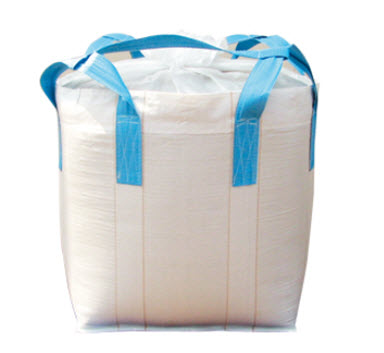The Flexible Intermediate Bulk Container (FIBC) is an industrial container intended for the storage and transport of dry, flowable products, e.g. pellets, powders, flakes or granules. Colloquially, the FIBC is commonly referred to as “Big Bag” or “Bulk Bag”.
A few examples of dry, flowable products commonly stored and transported in FIBCs:
- Grains
- Groundnuts, such as peanuts
- Seeds
- Starch
- Fertilisers
- Fibreglass
- Certain pharmaceutical drugs
- Pigments
- Concrete or mortar intended for shotcrete
- Sand
- Gravel
- Plastics
- Refractories
Material
FIBC:s are usually made from thick woven polyethylene or polypropylene. The material can be coated or uncoated.
Size
FIBCs can be created in virtually any size, but a diameter of approximately 110 cm is the most common format and the height is typically within the 100 cm – 200 cm span.
Weight
One advantage with the FIBC is that it weighs very little. It is not uncommon for a FIBC capable of of handling one metric ton of content to weigh just 3 kg or even less.
Loops
Most FIBCs have loops that can be utilised when lifting the bag.
Several different configurations are available, including FIBCs with one loop, two loops or four loops.
Discharge
Many FIBCs have a discharge spout or similar at the bottom, but there are also FIBCs that you simply cut open when its time to get the content out.
Structural forms
FIBCs are available in many different structural forms. Here are a few of the most commonly utilised ones:
| Round |
| Circular / Tabular |
| Four side panel |
| U-Panel |
| C-Panel Q bag |
| Core |
| Baffle |
| GN Drive |
Electrostatic properties
The standardisation system for FIBCs divides these containers into four different categories (A-D) based on their electrostatic properties.
Type A: Type A containers have no special safeguards against electrostatics
Type B: Type B containers are constructed in a way that makes it impossible for them to generate propagating brush discharges. The wall exhibits a breakdown voltage of 4 kilovolts or less.
Type C: Type C containers are known as Conductive FIBCs. These containers have an electrically conductive fabric. The conductivity of the fabric is intended to control electrostatic charges by grounding.
Type D: Type D containers are known as Anti-static FIBCs. They have anti-static or static dissipative properties and do not need touch anything else (grounding) to work.
History
Today’s modern FIBCs were developed as larger alternatives to the sacks commonly used for storage and transportation of various commodities.
In the 1940s, the rubber industry made their own FIBCs from PVC rubber to create containers suitable for the transportation of carbon black, an important reinforcing agent in various rubber products.
By the 1960s, the FIBCs had begun to look very similar to the FIBCs we use today, thanks to advances in weaving and the development of polypropylene. FIBCs became widely available during this era and were especially popular among oil and chemical companies who needed to transport and store large quantities of granular products.
In the mid-1970s, enormous quantities of cement were exported from Europe to to oil-producing countries in the Middle East – in FIBCs.
FIBCs in flood barriers
In many cases, the FIBC is an appealing alternative to small traditional sandbags when there is a need to quickly construct flood barriers. It is not overly difficult to source FIBCs that will be at least 3 feet x 3 feet x 4 feet when filled with sand, and this is 400 times the size of regular sandbags.
One example of a situation where FIBCs were used to create temporary flood barriers is the Thailand floods of 2011. Here, they became known as Big Bag Barriers.
Filtering
Special FIBCs have been developed to hold and filter fluid products.
